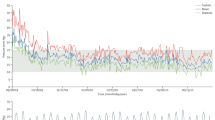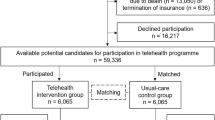Abstract
Telehealth has emerged as a promising approach for optimizing outcomes in chronic heart failure (CHF). Telehealth is broadly defined as the use of audio, video, and other telecommunications and electronic information technologies to offer health services, transfer various types of information, and assist healthcare personnel at remote sites. The use of telehealth as a strategy for the management of CHF can be very beneficial in combating episodes of exacerbation and preventing rehospitalizations, urgent care visits, and emergency room visits. This article provides a review of the use of telehealth and telemanagement in CHF, including a discussion of telehealth modalities and research on telehealth for CHF management.




Similar content being viewed by others
References
American Heart Association. Heart disease and stroke statistics: 2003 update [online]. Available from URL: http://www.americanheart.org. [Accessed 2003 Aug 20]
Ueshima H. Population differences in serum total cholesterol level and coronary heart disease [paper presentation]. XIIIth International Symposium on Atherosclerosis; 2003 Sep 28–Oct 2; Kyoto, Japan
International Atherosclerosis Society. Harmonized clinical guidelines on prevention of atherosclerosis and cardiovascular disease [online]. Available from URL: http://www.athero.org/ [Accessed 2003 Feb 10]
National Heart, Lung, and Blood Institute, National Institutes of Health. Data fact sheet: congestive heart failure in the United States: a new epidemic [online]. Available from URL: http://www.nhlbi.nih.gov/health/public/heart/other/CHF.htm [Accessed 2003 Aug 29]
Albert NM. Manipulating survival and life quality outcomes in heart failure through disease state management. Crit Care Nurs Clin North Am 1999; 11(2): 121–41
Field MJ, Grigsby J. Telemedicine and remote patient monitoring. JAMA 2002; 288: 23–425
Grady KL, Dracup K, Kennedy G, et al. Team management of patients with heart failure: a statement for healthcare professionals from the cardiovascular nursing council of the American Heart Association. Circulation 2000; 102(19): 2443–56
McAlister FA, Lawson FM, Teo KK, et al. A systematic review of randomized trials of disease management programs in heart failure. Am J Med 2001; 110(5): 378–84
Philbin EF, Rocco TA, Lindenmuth NW, et al. The results of a randomized trial of a quality improvement intervention in the care of patients with heart failure: the MISCHF Study investigators. Am J Med 2000; 109(6): 443–9
Warner P, Hutchinson C. Heart failure management. J Nurs Adm 1999; 29(7–8): 28–37
University of Calgary Health Telematics Unit. State of the science report. Socioeconomic impact of telehealth: evidence now for health care in the future [online]. Available from URL: http://www.fp.ucalgary.ca/telehealth/SOS%20Final%20Report.pdf [Accessed 2003 Aug 20]
Ackerman M, Craft R, Ferrante F, et al. Telemedicine/telehealth: an international perspective. Telemedicine technology. Telemed J E Health 2002; 8: 71–8
De Lusignan S, Meredith K, Wells S, et al. A controlled pilot study in the use of telemedicine in the community on the management of heart failure: a report of the first three months. Stud Health Technol Inform 1999; 64: 126–37
Telemedicine Research Center 2002. What is telemedicine? [online]. Available from URL: http://trc.telemed.org/telemedicine/primer.asp [Accessed 2003 Aug 15]
Alberta Research Council. Telehomecare users requirements (2002) [online]. Available from URL: http://www.telehealthlab.com/pubs/Telehomecare_User_Requirements_200204042.htm [Accessed 2003 Dec 29]
Benatar D, Bondmass M, Ghitelman J, et al. Outcomes of chronic heart failure. Arch Intern Med 2003; 163(3): 347–52
Bondmass M, Bolger N, Bastro G, et al. The effect of physiologic home monitoring and telemanagement on chronic heart failure outcomes. Internet J Asthma Allergy Immunol 1999; 3: 2
Artinian NT, Harden JK, Kronenberg MW, et al. Pilot study of a web-based compliance monitoring device for patients with congestive heart failure. Heart Lung 2003; 32(4): 226–33
Heidenreich PA, Ruggerio CM, Bassie BM. Effect of a home monitoring system on hospitalization and resource use for patients with heart failure. Am Heart J 1999; 138: 633–40
Shah NB, Der E, Ruggerio C, et al. Prevention of hospitalizations for heart failure with an interactive home monitoring program. Am Heart J 1998; 135: 173–8
Cordisco ME, Beniamnovitz A, Hammond K, et al. Use of telemonitoring to decrease the rate of hospitalization in patients with severe congestive heart failure. Am J Cardiol 1999; 84(7): 860–2
Cameron A. Telemanagement minimizes hospitalization for CHF. Pharmacoeconomics Outcomes News 1998; 158: 3–4
Zimmerman L, Barnason S, Mieveen J, et al. Impact of a home communication intervention on postoperative recovery outcomes in CABG patients [abstract 3464]. Proceedings of the Midwest Nursing Research Society 26th Annual Research Conference; 2002 Mar; Cleveland
Bowles K, Marcus S, Basfield-Holland E. Outcomes of tele-video versus telephone follow up of high risk congestive heart failure home care patients [abstract]. Washington DC: State of the Science Congress; 2002 Sep
De Lusignan S, Wells S, Johnson P, et al. Compliance and effectiveness of 1 year’s home telemonitoring: the report of a pilot study of patients with chronic heart failure. Eur J Heart F 2001; 3: 723–30
Bennett SJ, Hays LM, Arnould M. Heart messages: a tailored message intervention for improving heart failure outcomes. J Cardiovasc Nurs 2000; 14(4): 94–105
Jenkins RL, McSweeney M. Assessing elderly patients with congestive heart failure via in-home interactive telecommunications. J Gerontol Nurs 2001; 27(1): 21–7
Palladino M, LeVan P, Spear S, et al. Quantification of interventions and outcomes in an outpatient telemanagement and care management congestive heart failure program. Congest Heart Fail 2000; 6(3): 146–51
Knox D, Mischke L. Implementing a congestive heart failure disease management program to decrease length of stay and cost. J Cardiovasc Nurs 1999; 14(1): 44–74
Mueller TM, Vuckovic KM, Knox DA, et al. Telemanagement of heart failure: a diuretic treatment algorithm for advanced practice nurses. Heart Lung 2002; 31: 340–7
Davis C. Heart link: healthcare informatics, 1999: 207-9. Available from URL: http://www.healthcare-informatics.com [Accessed 2002 May 8]
Heart Alert, S.E. Consortium. Available from URL: http://www.heartalert.net/Prescriptions/SEConsortium_files/frame.htm [Accessed 2003 Jan 9]
Dimmick SL, Burgiss SG, Robbins S, et al. Outcomes of an integrated telehealth network demonstration project. Telemed J E Health 2003; 9(1): 13–23
Moore SM, Brennan P, Visovsky C, et al. Effects of a computerized home support program on CABG recovery symptoms during the first week after discharge. Am J Crit Care 2001; 10: 210–1
Moore SM, Dolansky MA. Randomized trial of a home recovery intervention following coronary artery bypass surgery. Res Nurs Health 2001; 24: 93–104
Brennan PF, Moore SM, Bjornsdottir G, et al. HeartCare: an internet-based information and support system for patient home recovery after coronary artery bypass graft (CABG) surgery. J Adv Nurs 2001; 35: 699–708
Jerant A, Rahman A, Nesbitt T. Reducing the cost of frequent hospital admissions for congestive heart failure: a randomized trial of a home telecare intervention. Med Care 2001; 39(11): 1234–45
Jerant A, Rahman A, Martinez C, et al. A randomized trial of telenursing to reduce hospitalization for heart failure: patient centered outcomes and nursing indicators. Home Health Care Serv Q 2003; 22: 1–20
Stewart S, Pearson S, Horowitz JD. Effects of a home-based intervention among patients with congestive heart failure discharged from acute hospital care. Arch Intern Med 1998; 158(10): 1067–72
Johnston B, Wheeler L, Deuser J, et al. Outcomes of the Kaiser permanente telehome health research project. Arch Fam Med 2000; 9(1): 40–5
Dahle K, Smith J, Ingersol G, et al. Impact of a nurse practitioner on costs of managing inpatients with heart failure. Am J Cardiol 1998; 82(5): 686–8
Fonarow GC, Gawlinski A, Moughrabi S, et al. Improved treatment of coronary heart disease by implementation of a Cardiac Hospitalization Atherosclerosis Management Program (CHAMP). Am J Cardiol 2001; 87(7): 819–22
Paul S. Implementing an outpatient congestive heart failure clinic: the nurse practitioner role. Heart Lung 1997; 26: 486–91
American Telemedicine Association. Expanded medicare coverage of telemedicine passes the Senate [online]. Available from URL: http://www.atmeda.org/news/newres.htm [Accessed 2003 Aug 8]
Joint Commission on Accreditation of Health Care Organizations. Existing requirements for telemedicine practitioners explained. Joint Commission Perspectives 2003; 23: 4
National Archives and Records Administration. Federal Register Rules and Regulations. Telehealth Services 2001; 66(212): 55281–5
Jacobus C. Telemedicine technology review: why hasns’t telemedicine taken off yet? Cybernet Medical 2003. Available from URL: http://www.cybernetmedical.com/files/telemedicinereview.pdf [Accessed 2003 Aug 8]
Clough K, Mallinson M, Jarine I. The potential for telemedicine to improve coronary heart disease services. J Telemed Telecare 2001; 7 Suppl. 1: 49–51
ClinicalTrials.gov. 2003. Evaluating telehealth home care for elderly veterans with congestive heart failure [online]. Available from URL: http://www.clinicaltrials.gov [Accessed 2003 Aug 20]
CRISP. Monitoring of heart failure patients via the internet. 2003. Available from URL: http://crisp.cit.nih.gov/crisp [Accessed 2003 Aug 20]
Acknowledgments
The authors report no funding has supported the preparation of this manuscript and they report no conflict of interest with the material presented.
Author information
Authors and Affiliations
Corresponding author
Rights and permissions
About this article
Cite this article
Kleinpell, R.M., Avitall, B. Telemanagement in Chronic Heart Failure. Dis-Manage-Health-Outcomes 13, 43–52 (2005). https://doi.org/10.2165/00115677-200513010-00005
Published:
Issue Date:
DOI: https://doi.org/10.2165/00115677-200513010-00005




